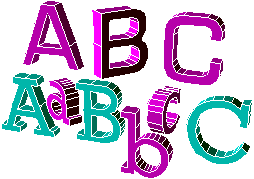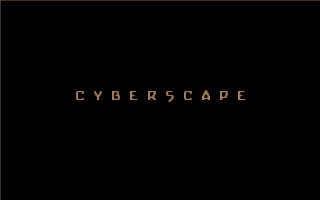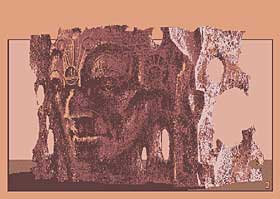Make Art
Earlier, in 1986, shortly after releasing CAD-3D 1.0, Tom Hudson had turned out a few inexpensive “accessory” products, including two collections of 3D “clip art”. One product was called the CAD-3D Collection I, which contained an assortment of polished CAD-3D models including a computer monitor, a space shuttle, the Enterprise from Star Trek, an electrical wall outlet and a Japanese battle helmet. The other collection was “Fonts, Primitives, Hints and Tips” (later renamed 3D Fonts I), which featured 3D letters of the alphabet in both serif and sans-serif designs. Similar to stock photography, these 3D letters were time-saving design resources specifically meant to be integrated into other projects, rather than as an end to themselves. Gary explains:

To be honest, the idea for the design disks came from Enabling Technologies [the makers of Easy3D], who had a disk of 3D clip art of letters, numbers and common symbols. It was extremely rudimentary, but it did give me the idea that folks could use canned 3D artwork. So, I can’t take credit for the original idea—as usual I found a good idea that was incompletely executed and embellished upon it.
Tom’s font disk was a solid product, but Gary took 3D clip art in a new direction with Darrel Anderson, another key individual who turned up about this time.
Since the ST now had powerful (for the time) paint tools such as DEGAS Elite and Atari’s own NeoCHROME, it was only natural for Antic Magazine to sponsor an art competition. Darrel’s entry was on an entirely different level from any of the other submissions. Here was a “real artist”—not just a computer geek—using computers to make “real artwork”. Gary wasted no time in engaging Darrel, who produced tutorial articles for START, fascinating demos and clip-art products for Antic, not to mention loads of inspiration. The energizing effect that Darrel’s work had on both Antic’s software development and on the user base cannot be underestimated.
As the unofficial artist-in-residence for the Cyber software, Darrel always had access to software under development, such as CAD-3D 2.0. Gary continues:

Stills from Cyberscape
Darrel did some interesting Sci-Fi artwork with CAD-3D, and when I got a hold of his data I started playing around with it and thought it'd be a great idea for non-artistic folks like myself to have those kinds of objects to make cool stuff with.
Gary ultimately convinced Darrel to undertake two projects from his initial CAD-3D work: one was the “3-D feature film on disk” Cyberscape, which would essentially introduce the animation potential of CAD-3D and Cybermate to the world. The resulting demo is both a testament to the extreme limitations of the Atari ST (including the fact that the demo had to fit on a single 720KB floppy disk) and a mark of how far the software had come.

Conceptual storyboards from Cyberscape that appeared in The Catalog
The other project was the Future Design Disk, an extensive collection of futuristic forms that were artistically realized. In other words, cool geometry that anybody could use but that nobody but Darrel could have come up with on his or her own because it reflected Darrel’s unique sense of style.
During the next couple of years, Darrel and his friend Richard Berry produced three more design disks for Antic. Darrel also went on to develop unique plug-in modules for 3D Studio and create special effect sequences for the film Johnny Mnemonic. Today, Darrel remains an active artist and software developer (please visit www.braid.com). Gary also revived the spirit of the design disks in different form for Autodesk 3D Studio as the World Creating Toolkit: a CD-ROM packed with artistic resources for that software.
